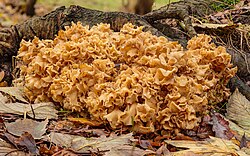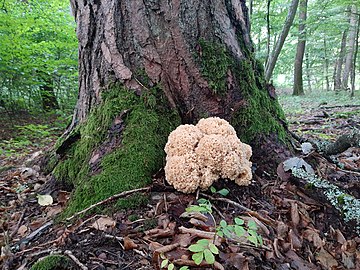Biology:Sparassis crispa
| Sparassis crispa | |
|---|---|

| |
| Scientific classification | |
| Domain: | Eukaryota |
| Kingdom: | Fungi |
| Division: | Basidiomycota |
| Class: | Agaricomycetes |
| Order: | Polyporales |
| Family: | Sparassidaceae |
| Genus: | Sparassis |
| Species: | S. crispa
|
| Binomial name | |
| Sparassis crispa (Wulfen) Fr. (1821)
| |
| Synonyms | |
| |
| Sparassis crispa | |
|---|---|
| Mycological characteristics | |
| smooth hymenium | |
| no distinct cap | |
| hymenium attachment is irregular or not applicable | |
| lacks a stipe or is bare | |
| spore print is white to cream | |
| ecology is saprotrophic | |
| edibility: choice | |
Sparassis crispa is a species of fungus in the family Sparassidaceae. It is sometimes called cauliflower fungus.[1]
Description
S. crispa grows in an entangled globe that is up to 60 centimetres (24 inches) in diameter. The lobes, which carry the spore-bearing surface, are flat and wavy, resembling lasagna noodles, coloured white to creamy yellow. When young they are tough and rubbery but later they become soft. They are monomitic.[2] The odour is pleasant and the taste of the flesh mild.
The spore print is cream, the smooth oval spores measuring about 5–7 µm by 3.5–5 µm.[3][2] The flesh contains clamp connections.[4]
Similar species
The less well-known S. brevipes, found in Europe, can be distinguished by its less crinkled, zoned folds and lack of clamp connections.[4][2]
Distribution and habitat
This species is fairly common in Great Britain and temperate Europe (but not in the boreal zone). It is a brown rot fungus, found growing at the base of conifer trunks, often pines, but also spruce, cedar, larch and others.[4][2]
Uses
It is considered a good edible fungus when young and fresh,[3] though it is difficult to clean. (A toothbrush and running water are recommended.) One French cookbook, which gives four recipes for this species, says that grubs and pine needles can get caught up in holes in the jumbled mass of flesh. The Sparassis should be blanched in boiling water for 2–3 minutes before being added to the rest of the dish.[5][1] It should be cooked slowly.[6]
See also
References
- ↑ 1.0 1.1 Roger Phillips (1998). Mushrooms and other fungi of Great Britain & Europe. Cavaye Place, London SW10 9PG: Pan Books. p. 255.
- ↑ 2.0 2.1 2.2 2.3 Læssøe, H.; Petersen, Jens (2019). Fungi of Temperate Europe. Princeton University Press. p. 954. ISBN 978-0-691-18037-3.
- ↑ 3.0 3.1 Marcel Bon (1987). The Mushrooms and Toadstools of Britain and North-western Europe. 7 Bond Street, St. Helier, Jersey: Domino Books Ltd.. p. 308. ISBN 978-0-340-39935-4.
- ↑ 4.0 4.1 4.2 Geoffrey Kibby (2017). Mushrooms and Toadstools of Britain & Europe Vol. 1. Geoffrey Kibby. p. 82. ISBN 978-0-9572094-2-8.}
- ↑ Frédéric Jaunault; Jean-Luc Brillet (1981) (in French). Toutes les bases de la cuisine aux champignons. 13 rue du Breil, Rennes, France: Editions Ouest-France. p. 183. ISBN 2-7373-2275-8.
- ↑ Miller Jr., Orson K.; Miller, Hope H. (2006). North American Mushrooms: A Field Guide to Edible and Inedible Fungi. Guilford, CN: FalconGuides. p. 438. ISBN 978-0-7627-3109-1.
External links
Wikidata ☰ Q36992 entry
 |



